Smog engulfs Delhi post flurry of crackers on DiwaliResidents in many parts of Delhi-NCR woke up with an itchy throat and watery eyes as a thick layer of acid smog engulfed the region following rampant cracker-bursting on Diwali night. A likely increase in fumes from farm fires will add further woes to this situation.
Last Updated IST

Smog engulfs Delhi post flurry of crackers on Diwali

The capital's air quality had entered the severe zone on Diwali night as people burst firecrackers on Diwali in a blatant disregard to the government's ban on it amid a sharp increase in smoke from farm fires. Credit: PTI Photo
Residents in many parts of Delhi-NCR also woke up with an itchy throat and watery eyes as a thick layer of acrid smog engulfed the region following rampant crackers bursting on Diwali night. A likely increase in fumes from farm fires will add further woes to this situation. Credit: PTI Photo
According to the Central Pollution Control Board (CPCB), the 24-hour average concentration of lung-damaging fine particles known as PM2.5 in Delhi-NCR shot up from 243 micrograms per cubic metre at 6 pm on Diwali day to 410 micrograms per cubic metre on November 5 morning, around seven times the safe limit of 60 micrograms per cubic metre. Credit: PTI Photo
The extremely calm wind conditions in Delhi combines with a 25 per cent stubble share are two major factors of pollution. Credit: PTI Photo
During winter months pollution levels surge in northern India, as lower temperatures and a drop in wind speed tend to trap pollutants in the air longer. Credit: PTI Photo
Every year, either government authorities or India's Supreme Court impose a ban on firecrackers. But the bans rarely appear to be enforced. Credit: PTI
Airborne PM2.5 can cause cardiovascular and respiratory diseases such as lung cancer. And, in India, toxic air kills more than a million people annually. Credit: PTI Photo
Vehicles ply amid low visibility due to a thick layer of smog, a day after Diwali celebrations in New Delhi. Credit: PTI Photo
The neighbouring cities of Faridabad (454), Greater Noida (410), Ghaziabad (438), Gurgaon (473) and Noida (456) also recorded severe air quality on the next day of Diwali. Credit: Reuters Photo